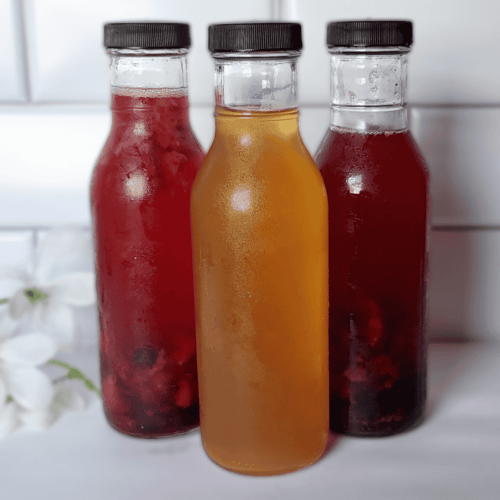
Kombucha, First and Second Fermentation Recipe
Discover the ancient art of brewing kombucha in your own kitchen with this easy to follow guide!
Equipment
- 1 gallon glass or lead-free porcelain jar (I use one with a dispenser but that's optional)
- Breathable cover (muslin cloth, cheesecloth, thin tea towel, coffee filter, etc.)
- Rubber band
- Small to medium pot
- Strainer, tea ball, or muslin tea bag (if using loose-leaf tea)
- Long spoon (wooden, silicone, or plastic)
- 16 oz bottles (6-7), or 12 oz bottles (7-8) (carbonation-safe bottles designed to hold pressure build-up)
- Pitcher or glass measuring cup with spout (optional), or simply use a funnel
- Separate glass container (to store the SCOBY with 2 cups of kombucha starter tea for future use)
Ingredients
Kombucha First Fermentation:
- 2 cups spring or filtered water (to make a concentrated tea)
- 10 cups room temperature water (use spring or filtered water)
- 2 - 3 tbsp loose-leaf black or green tea, or 6 - 8 tea bags (I use black tea; use 2 tablespoons or 6 tea bags for a slightly milder tea, and 3 tablespoons or 8 tea bags for a stronger tea)
- 3/4 cup organic cane sugar
- 1 live kombucha SCOBY (not dehydrated)
- 1.5 - 2 cups kombucha starter tea (if you purchase a live SCOBY it usually comes in a starter tea, alternatively you can use store-bought raw unpasteurized unflavored kombucha)
Kombucha Second Fermentation:
- Fresh fruit (pureed, mashed, diced, or whole) or fruit juice (the live cultures need a sugary source of food, and this will also help create carbonation)
- Herbs of choice (optional)
- Organic cane sugar (only if you don’t want to use fruit/fruit juice, or if you’re using fruit with low sugar content like just about any berry, wild blueberries, cranberries, rhubarb, lemon, or lime)
Instructions
Kombucha First Fermentation:
- Brew a concentrated batch of sweet tea by bringing two cups of water to a boil. Turn the heat off, add the tea, and let it steep for 10-15 minutes. Remove the tea ball or muslin tea bag, or strain to remove the leaves. Add the sugar and stir until dissolved.
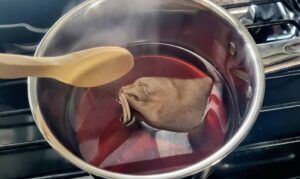
- Pour the hot sweet tea into the 1 gallon jar, and then add 10 cups of room temperature water to it. This helps cool down the hot tea; you can't add the SCOBY or starter tea to hot liquids, as the live cultures can die. The temperature of the tea should be below 85°F (29°C), but not too cold.
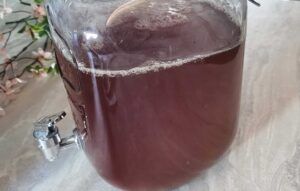
- Add the kombucha SCOBY and 1.5 - 2 cups of starter tea to the jar, then give it a gentle stir.
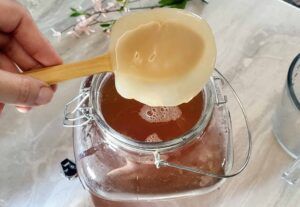
- Cover the opening of the jar with the breathable cloth and secure it with a rubber band.
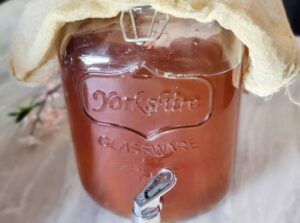
- Place jar on top of a counter, or in the pantry, away from direct sunlight. Leave it undisturbed for 7-14 days. Feel free to taste it around the 7 day mark to see if it still tastes sweet. If so, leave it out for another few days to 1 week. When it's done, it should be just slightly sweet, with tangy and vinegary notes. The fermentation time depends on the temperature in the home; the colder it is, the slower it ferments, the warmer it is, the faster it ferments.
- At this point the first fermentation is done. If you don't wish to put it through a second fermentation for flavoring and carbonation, you can transfer the kombucha to bottles and refrigerate them.
- NOTE: Whether you choose to stop after the first fermentation or put it through a second fermentation, you'll want to first remove the SCOBY and 2 cups of the kombucha tea, and place them in a separate glass jar. This is what you will use to make a future batch of kombucha. Secure a breathable cover over it, and store it in a cool and dark location like a pantry or cabinet until you are ready to use it again.
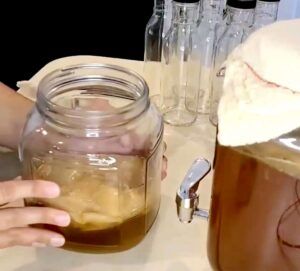
Kombucha Second Fermentation:
- Stir the remaining kombucha (to reincorporate all of the yeast and live cultures throughout).
- If using 12 oz bottles, add 1/4 cup of fruit juice, or pureed or fresh fruit, into each of your bottles (using a funnel will help). If using 16 oz bottles, add 1/3 cup. If you are not using fruit or juice, or are using fruit with low sugar content, add 1 teaspoon of sugar to each 12 oz bottle, or 1.5 teaspoons to each 16 oz bottle.
- Pour the kombucha into a pitcher or a glass measuring cup with a spout (to make pouring into the bottles easier), or simply use a funnel. Top each bottle off with kombucha tea, leaving about 1/2 - 1 inch of headspace at the top of the bottles.
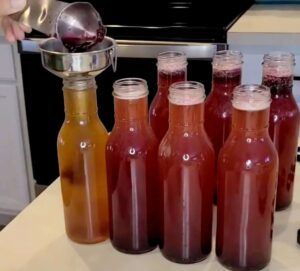
- Place all of the lids on tightly, and then invert them gently a few times to incorporate the fruit/sugar into the tea.
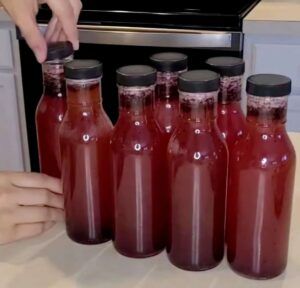
- Leave the bottles out on your counter or pantry, away from direct sunlight, for 2-4 days. If it's pretty warm in your house, check them after 1 day.
- At the 1-2 day mark, open a bottle to check for carbonation. If the carbonation is to your liking, refrigerate all of the bottles to stop the fermentation and carbonation process. If you want more carbonation, leave them out for another 1-2 days, then check again.
- Once your kombucha has reached the level of carbonation that you like, transfer the bottles to the refrigerator to stop further fermentation.
- Strain the fruit pulp before enjoying (optional, some people like drinking it with the pulp).
- You now know how to make kombucha, and can share the recipe with friends and family. Cheers!
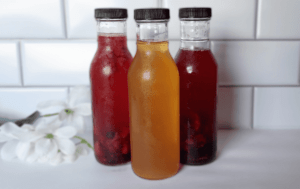
Notes
Some fruits ferment faster than others. When I use strawberries or blackberries, the second fermentation is done in just 1 day vs 2-4 days with other fruits. To be safe, check bottles for carbonation after 1 day.
Please see post for awesome second fermentation flavor ideas, as well as additional information, tips, and what to expect, for brewing the perfect kombucha.
I usually end up filling (8) 12 oz bottles of kombucha and having 4-6 ounces left over. I refrigerate what's left over and enjoy it chilled without putting it through the second fermentation.
Kombucha is typically not high in sugar by the time it’s ready to drink. During the fermentation process, the yeast and cultures eat most of the sugar and convert it into beneficial acids, gases, and probiotics.
The reason we use organic cane sugar is because it’s the easiest for the SCOBY to break down. Other types of sugars like turbinado, coconut, brown sugar, maple syrup, etc., are harder for the SCOBY to process and can stress it out over time.
There are no "exact" fermentation times, because so many variables exist (like the temperature in your home, the type of fruit you use, etc.). The only true way to know your brew is ready is to taste it. Your kombucha is ready when it has the balance of sweetness and tang that you like. A shorter ferment will be sweeter, while a longer one will be more tangy and tart.
This 1 gallon kombucha recipe calls for 3/4 cup of organic cane sugar, which is enough, but you can use up to 1 cup of sugar if you wish.
Kombucha ferments best between the temperatures of 75-85°F (24-29°C), although this isn’t a hard rule. Just know the warmer the room temperature, the faster it will ferment; the colder the room temperature, the slower it will ferment.
Black tea is the most commonly used, and it's traditional, but you can experiment with green tea, oolong, or white tea. Just try to avoid teas with added flavors or oils, as they can harm the SCOBY.